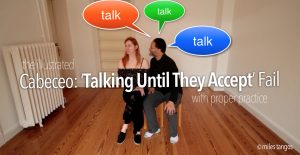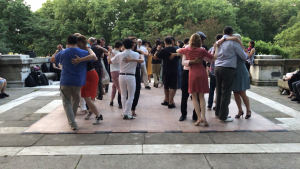Berlin, as in Berlin, Germany is known for many reasons around the world, its culture, its Berlin accent of German, it’s fact as a post-cold war city, and most recently the financial capital of Europe. Tango was certainly not on that list. If however, you happen to be a Tango dancer, and at a very specific place in your dance, then you have heard Yoda-like whispers of “Berlin…go to Berlin you should, mmmm yes Berlin, go young padawan, you must go to Berlin…”. There’s a reason for those whispers, which has turned into ‘talk’. It’s because there is a reason for all the ‘fuss’ over Tango in Berlin.
You’re going to ask a question “Why are we talking about ‘X’ city ? I don’t care about X. I want to know where tango is danced locally!” Why ? Well for one reason because you do need to travel. The more that you travel, the more diverse you become as a dancer, and versatility is one of the key components to become a better and very desirable dancer! Secondly, at some point you or someone you know is going to want to venture beyond your circle of milongas, to go to what seem like far away places. So it’s good to have an on the ground assessment of what you might find there. This is the quick and dirty assessment of Tango in Berlin, or if you’re looking for other international cities and need information, this is a becoming a good resource of facebook groups -> Tango Cities.
This Tango thought should be presented with a warning right up front: If you’ve been dancing for about 20 minutes in your local scene and you think or believe you’re ‘good’. Think again. Berlin is a whole different animal on multiple levels. It is not for the faint of heart. You have to be on your game otherwise you’re going to sit. It’s that simple. It doesn’t mean that you have to be the best of the best of the best. It just means, that when you get there you’ll see why we are saying this now. You’ll see all manner of clean, clear, close embrace dancing that will make you wonder what on earth you’ve been doing all this time. So this serves as a warning. There’s more to come in this Tango Thought.
Now to the ‘fuss’. 🙂 The deal with Berlin, and the question of whether or not it lives up to it’s reputation or not ? In a single word: YES! Emphatically so. The quality of dance meets or in this case exceeds all expectations. The quantity of dance meets, or in this case, exceeds most cities. One thing that gets talked about is the seemingly ‘cold’ behavior of Berlin Tango, sometimes seen as ‘snobbishness’, which happens in every Tango community, is also present here. And while it would be easy to state that ‘cold’ behavior as just ‘Germans!’, that would be wrong. The German people are quite warm, quite giving, and quite frank if nothing else. As to what will appear as ‘snobbishness’ in this case of the Berlin tango scenc it’s not snobbishness, it’s just that there is a certain level of dance that happens in Berlin, which creates the perception of aloofness in the dancers. It is a perception, and a reality. In many ways one might say that what’s happening in Berlin rivals what’s going on in Moscow, New York, Istanbul, Los Angeles, and most certainly gives Buenos Aires a run for it’s money as the Tango capital of the world. No one would argue that Berlin is the cultural center of Tango in Europe. It’s certainly the largest, has the largest tango populace either equaling or rivaling that of NYC or Moscow as the largest tango center (volume of dancers). So when we talk about ‘fuss’ we’re referring to number of dancers, quality of dance, quality of venue, number of venues, quality of djing (very important), number of schools, and last but not least the number of dancers that are generated by those schools dancing to a particular ideal. Berlin lives up to it’s ‘fuss’.
Secondly if you want to go, there are a few things you really want do before you do. 1.) 5 words for you: Work. On. Your. Close. Embrace! Not kidding. This is a Close Embrace venue city. More so than most. 2.) Still another word for you: Floorcraft! Learn it, know it, live it! Lanes and Lines of dance. Got it ? 3.) This one should be obvious but clearly, it’s not because there’s an awful lot of confusion about this one: LEARN HOW TO WALK! Seriously. Break it down, and put it back together again! And this is from a leading perspective as well as from a Following perspective! You may find that yourself sitting more than usual because some (if not most) of the dancers will seemingly judge what and how you’re walking. Mind you this happens in every city, it just seems that it happens a lot more in Berlin. 4.) Know your music! Not just the top 20 DiSarli tunes but most of his library, and Canaro’s, and Rodriguez, and Tanturi, and Troilo, and…and…and…and the top 20 orchestras in excess of about 2000 songs at minimum. Why ? Because you’re going to hear a lot of Tango music that you’ve probably never been exposed to before and you have not heard. 5.) Drop the flashy moves. You want to get noticed in Berlin ? Walk really well. And while they’ve seen it all before, it’s the walking part that get’s people to talking….so….Walk. Really. Well. 😉 and now one more….
Last, but not least, this one is going to cause some upset that it’s being singled out, there will certainly be some confusion over it, if not some statements of “that’s not true!” or “lies” or “bullshit!”. The ‘Berlin’ Embrace. There is a very specific idea, a variant of Close Embrace that is sometimes practiced/danced in Berlin. It is an idea that is not necessarily taught anywhere, at any Tango school in Berlin, nor is it all that common in some venues. However, this is something that you’ll see and experience from time to time.
What is The ‘Berlin’ Embrace ? It is a very specific embrace construct that is not body-on-body contact that is normally characterized as ‘Close Embrace’, but something akin to being ‘Close’ to someone and there’s a wrapping-of-the-arms-around-each-other-type-embrace involved. It’s like giving someone a hug without really hugging them, hips away from the partnership, torsos in towards each other without actually touching, there’s space between the partnership – not close and not open, there’s tension in the arms and fingers, all done with resistance. The only reason this is even mentioned here is so that you’re prepared it, and so that you don’t freak out. More than a few people (read that as non-berlin folks) have commented on it, and made note of it. So it’s here as an acknowledgment of what’s happening in Berlin, not as a disparagement of it. It can be fun to play with because it allows for a certain amount of space in the embrace, therefore an inordinate amount of vocabulary can be executed within that construct because there is that space. You be the judge of whether or not this is desirable or undesirable. YMMV.
Berlin attracts some of the best teachers in the world, and because there are so many dancers, and so many teachers there, it’s not uncommon to have a very famous teacher with about 5 or 8 students in their class! Berlin is a tough nut to crack teaching wise. So if you’re planning on going there to teach, stand in line, there’s a lot of them. There are more than a few Tango schools in Berlin that teach ‘Social Dancing’ and ‘Social Tango’ as it is danced not performed, not steps or patterns but actual Social Dancing skills. This is one reason why tango is desirable in Berlin. It’s not the only reason, but it’s a contributing factor. Another reason of why tango is desirable in Berlin has everything to do with shear volume of desirable Social Dancers that it attracts on a regular basis, they come, they visit, they dance, and then decide to stay for long periods of time, and play.
Still another reason of why Berlin is a desirable stop on your tango journey has everything to do with the volume or number of Marathons that happen there on what seems like a running basis. That’s not true, but there are a fair number of them. One Marathon turned into a weeklong explorative of showcasing the Milongas and Venues/Schools in Berlin: Embrace! This is probably one of the better showcase Marathon Milonga City Tango Venues ever (aside from what BsAs does on a daily basis). It really does show off all the venues, and all the milongas to their best. You should go and check it out. To be clear: There is another week-long venue that happens in Amsterdam at the end of the year which ended up taking the place of TangoMagia – Tango Train.
The Tango Topics Opinion: For the first time dance in Berlin, regardless of role, you’re going to have a hard time getting dances for a variety of reasons. And the OLDER you are, again, regardless of role, you’re going to have issues and concerns. There are several ways to mitigate those issues and concerns. 1.) WORK ON YOUR SKILLS! 2.) WORK ON YOUR SKILLS. 3.) Hmmm….this one is hard…WORK ON YOUR SKILLS! Are you getting that you need to work on your skills ? Good. Because THAT is your saving grace. This site has gone to great lengths to help you with that. Working on your technique, your foundation, informing you about what you need to work on and how. Follower Technique, Leading Technique, Vocabulary Suggestions (Building Blocks, Simple Sacadas, Social Colgadas, Social Volcadas, Social Boleos, Social Ganchos, just to name a few), as well as working on How to Listen to the music and what to listen for and more importantly what to do with it! The tools are here for you to use. Use them.
You’re going to have questions, lots of question, and the first of those questions is where… WHERE to go to dance ? We have compiled a small list of some venues to go and dance at: Milonga Popular on Mondays, El Ocaso or Roter Salon on Wednesdays, Villa Kreuzberg or Mambita (alt) on Thursdays, Nou on Fridays, Cafe Dominguez @ Mala Junta (Sunday afternoons), Max und Moritz (on Sunday nights), just to name a few of the more popular venues where you’ll find some rather nice social dancing. There is a Tango Guide (at the time of this writing) which is kept up to date called ‘Berlin Tango Guide’. It gives a listing of nearly every Milonga, Venue, and School, and the types of music played at the Milongas by percentages. It’s in English and German.
One more thing: Language. For the native English speaker that wants to visit Germany, and Berlin in specific, you’re going to have a concern that everyone speaks German, and that you’ll need to learn some German before you go. While it is always a good practice to learn the native language of the country that you’re visiting. In the case of Berlin, that’s not necessarily so. The reason is that Berlin is a multicultural city, and as such it has a very rich and diverse populace from many places, so you’ll hear English spoken a lot in the street, subways, cabs, train stations, etc. Remember that Berlin was a divided city until about 30+ years ago, with a huge American influence for almost 50+ years, so it’s no wonder that English is spoken. That said, what you’ll find as it relates to Tango is that a good portion of dancers speak many languages. German, English, Russian, Ukrainian, Polish, and Turkish (!!!) are very common.
- Glossary: Social Dancing
- Glossary: Close Embrace
- Glossary: Buenos Aires
- Glossary: Social Tango
- Glossary: Floorcraft
- Glossary: Resistance
- Glossary: Vocabulary
- Glossary: Foundation
- Glossary: Tango Marathon
- Glossary: Embrace
- Glossary: Feather
- Glossary: Tension
- Glossary: Milonga
- Glossary: Berlin
- Glossary: Leading
- Glossary: Walking
- Glossary: Open Embrace











